EINSTEIN PRESSES ROOSEVELT ON ATOMIC RESEARCH
Peconic, Long Island, New York • August 2, 1939
On this date in 1939, 1 month before the outbreak of World War II in Europe, distinguished German-born professor, mathematician, and physicist Albert Einstein wrote President Franklin D. Roosevelt about the possibility of using a nuclear chain reaction to produce enormous amounts of energy that could be used in making a bomb. The architect of Einstein’s letter was the brilliant but eccentric Hungarian-born physicist and inventor Leó Szilárd. German scientists, the 2 men noted in closing the letter to Roosevelt, were busy researching just that possibility, having formed a Uranverein (Uranium Club) earlier in April as part of their country’s clandestine efforts to develop and produce nuclear weapons of war. Not 5 months earlier, in December 1938, German physicists stunned Einstein and other scientists who had escaped Nazi-occupied Europe by announcing they had split the uranium atom, a process later designated nuclear fission. Roosevelt did not receive Einstein’s confidential hand-delivered letter until October 11, but when he did he acted on it quickly, appointing a committee, the S‑1 Uranium Committee, to direct U.S. nuclear research starting with a paltry $6,000 outlay.
In December 1942 Italian-born physicist Enrico Fermi and the aforementioned Szilárd—colleagues Einstein had mentioned in his letter to Roosevelt—went on to create the first atomic chain reaction at the University of Chicago and became members of the Manhattan Engineering District, the cover name for America’s atomic bomb program that evolved out of the S‑1 Committee. (The project’s cover name derived from the then concentration of nuclear energy expertise in Manhattan, a New York City borough.) Leading the civilian scientific side of the project was a young 38‑year-old American theoretical physicist, J. Robert Oppenheimer. Overseeing the nearly $2 billion project (over $35.7 billion in 2025 dollars adjusted for inflation) was the Manhattan Project’s military director and West Point graduate Brig. Gen. Leslie Groves, who had overseen the construction of the Pentagon.
Apart from the initial July 16, 1945, detonation of a nuclear (plutonium) bomb nicknamed “Gadget” at the top of a 100 ft./30 m tower in the New Mexico desert, Manhattan Project’s deployable nuclear weapons were “Little Boy” (uranium bomb) and “Fat Man” (plutonium bomb). (Szilárd and 154 nuclear scientists lost the moral argument at the highest levels of the new Truman administration to invite Japanese and international observers to view a second noncombat nuclear detonation, which they believed would have induced Japan’s leaders to surrender unconditionally and thus spare lives. The weight of opinion was on the side of those who saw powerful strategic and practical benefits from using the bomb and ruled out a preview and warnings that the bomb was coming.)
Initially 6 Japanese cities were identified as candidates for nuclear incineration. The list was later reduced to 4: Hiroshima on southern Honshū Island, the largest of the Japanese Home Islands; Kokura (Hiroshima’s backup) and Nagasaki (Kokura’s backup) on Kyūshū, the southernmost Home Island; and Niigata on northern Honshū. Weather that permitted visual bombing settled Hiroshima’s terrible fate; clouds and smoke over Kokura from an earlier U.S. firebombing of Yawata (Yahata), less than 5 miles/8 km away, settled that of Nagasaki. On August 15, 6 days after Nagasaki and tens of thousands of deaths later, Emperor Hirohito (posthumously referred to as Emperor Shōwa) announced his country’s unconditional surrender to the Allies. The Japanese Instrument of Surrender, signed on September 2, 1945, aboard the U.S. battleship Missouri at anchor in Tokyo Bay, officially ended World War II.
Trinity Site, New Mexico, 1945: Detonating the First Nuclear Bomb
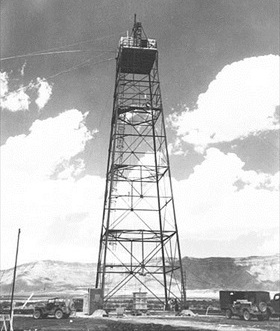 | 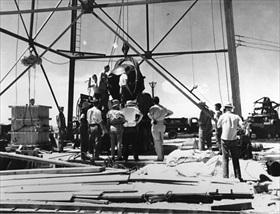 |
Left: The 100-ft./30-m-tall steel tower constructed at a small Army airfield for the Trinity test. Inspired by the “three-person’d God” in a sonnet written by English poet and cleric John Donne, Trinity was the codename chosen by Oppenheimer for the desert site where the world’s first detonation of a nuclear device occurred, this on July 16, 1945, a date usually considered to be the beginning of the Atomic Age. Trinity was located on the Alamogordo Bombing and Gunnery Range (now part of the White Sands Missile Range) in a particularly dry stretch of southern New Mexico desert called the Jornada del Muerto—Spanish for “Journey of the Dead Man.” Trinity lay 200 miles/320 km south of Los Alamos, where the atomic bombs were designed and built.
![]()
Right: The explosives of the 5-ton “Gadget” were carefully hoisted to the corrugated-steel shelter at the top of the tower for final assembly in mid‑July 1945.
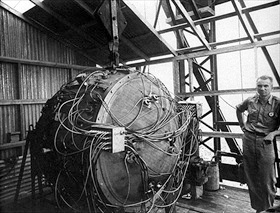 | 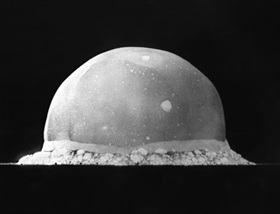 |
Left: Norris Bradbury, bomb assembly group leader, stands next to the partially assembled “Gadget” atop the test tower, July 15, 1945. Among other things, Bradbury had to ensure that the series of detonators needed to set off a nuclear chain reaction inside “Gadget” fired simultaneously within a fraction of a millionth of a second, otherwise the plutonium would “fizzle” and not produce a nuclear explosion. The July test of the plutonium device turned out to be an unqualified success. Frank Oppenheimer watched his brother hardly breathing in the last few seconds before “Gadget” exploded; after it did his brother’s face relaxed into an expression of tremendous relief. Robert Oppenheimer simply said: “I guess it worked.”
![]()
Right: Trinity was a test of an implosion-design plutonium device, the same conceptual design used in the second nuclear device dropped on Japan, “Fat Man,” which was detonated over Nagasaki, Japan, on August 9, 1945. This photo was taken at 5:30 a.m., a 0.016 second after test detonation. The searing light of the explosion was more intense than anything ever witnessed before and could have been seen from space. Its core temperature was 4 times greater than that at the sun’s core. The awesome roar of the air blast 30 seconds later “warned of doomsday,” reported one witness. Oppenheimer later remarked that the detonation reminded him of a passage from the second-century BCE Hindu Bhagavad Gita: “Now I am become Death, the destroyer of worlds.”
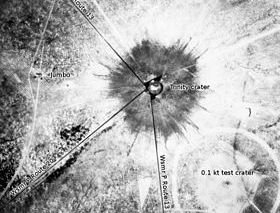 | 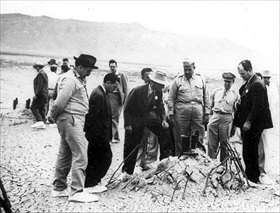 |
Left: An aerial photograph of the Trinity crater shortly after the test. The nuclear device exploded with an energy equivalent to around 20 kilotons of TNT and left a crater of radioactive glass 10 ft./3 m deep and 1,100 ft./335 m wide. Nothing remained of the 100‑ft./30‑m-tall steel tower. The shock wave was felt over 100 miles/161 km away, and the mushroom cloud reached 7.5 miles/12 km in height. U.S. President Harry S. Truman was positively giddy with new confidence on a swift victory in the 4‑year Pacific War. From the Big Three victors’ conference in Potsdam near the former Nazi capital, Berlin, Truman wrote his wife in mid-July 1945: “We’ll end the war a year sooner now, and think of the kids [U.S. service members—ed.] who won’t be killed.”
![]()
Right: J. Robert Oppenheimer (center, in dark suit and light-colored hat), Brig. Gen. Leslie Groves (in khaki uniform to Oppenheimer’s left), and other scientists and military personnel inspect the melted remains of the test tower at ground zero after the Trinity blast. The photo was taken in September when some participants returned for news reporters. Note men wearing shoe covers to keep from picking up radiation. The test site was littered with lopsided marbles and knobbly sheets that later became known as Trinitite. Trinitite was primarily quartz and feldspar, tinted sea green with minerals in the desert sand, with droplets of condensed plutonium sealed into it.The test site was littered with lopsided marbles and knobbly sheets that later became known as Trinitite. Trinitite was primarily quartz and feldspar, tinted sea green with minerals in the desert sand, with droplets of condensed plutonium sealed into it.
University of California Television: The Manhattan Project
![]()

 History buffs, there is good news! The Daily Chronicles of World War II is now available as an ebook for $4.99 on Amazon.com. Containing a year’s worth of dated entries from this website, the ebook brings the story of this tumultuous era to life in a compelling, authoritative, and succinct manner. Featuring inventive navigation aids, the ebook enables readers to instantly move forward or backward by month and date to different dated entries. Simple and elegant! Click
History buffs, there is good news! The Daily Chronicles of World War II is now available as an ebook for $4.99 on Amazon.com. Containing a year’s worth of dated entries from this website, the ebook brings the story of this tumultuous era to life in a compelling, authoritative, and succinct manner. Featuring inventive navigation aids, the ebook enables readers to instantly move forward or backward by month and date to different dated entries. Simple and elegant! Click 











